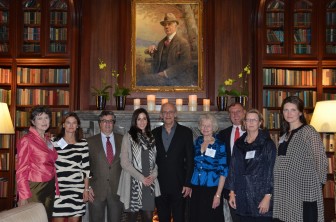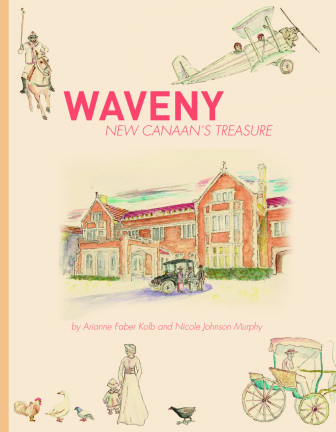The widely anticipated launch of a Waveny-inspired children’s book on Sunday is drawing back one of the cherished public building’s most prominent former residents, officials say: Christopher Lloyd.

In the library of Waveny House beneath the portrait of Lewis Lapham: Rose Scott Rothbart, Arianne Faber Kolb, Robert E. Mallozzi, Lisa Lloyd, Christopher Lloyd, Mimi Findlay, Steve Benko, Amy Weber Reid, Rebecca Stedman.
The Emmy Award-winning actor—of “One Flew Over the Cuckoo’s Nest,” “Taxi” and “Back To The Future” fame—is the son of Ruth Lapham Lloyd, and grew up in Waveny House before his mother gave it, as well as all other buildings and the sprawling acreage that made up the estate, to the town.
His attendance at the launch of “Waveny: New Canaan’s Treasure” is “significant and wonderful,” said Arianne Faber Kolb, author of the book, which is illustrated by Nicole Johnson Murphy and whose publication was made possible by a New Canaan Community Foundation grant and funding from the town.
 “He is really the history of this place and it’s his story and his family’s history and his own personal story is so tied to Waveny and the house, so it is really special for the town and community that he is still attached to this and would like to continue to be involved with anything that has to do with Waveny, and he has expressed that.”
“He is really the history of this place and it’s his story and his family’s history and his own personal story is so tied to Waveny and the house, so it is really special for the town and community that he is still attached to this and would like to continue to be involved with anything that has to do with Waveny, and he has expressed that.”
He’s also made good on that promise.
Lloyd attended the 100th anniversary celebration of Waveny House in 2012—an event organized by the New Canaan Preservation Alliance—and told attendees stories about growing up at the beloved building and property.
“This Waveny meant so much to me,” he said at the time. “It still means that much to me. If my mom could be here and see what all of you have done to preserve this place and put it to so many uses for the community, she would know that her dream had come true. It’s a wonderful thing you have all done.”
In late 2014, as the town was debating whether to seeking a listing for Waveny on the National Register of Historic Places, Lloyd penned a letter to the Town Council urging the municipal body to do so.
Kolb said that Lloyd “truly cares” about Waveny House and what it means to the town “and to see the legacy of his mother, and that’s part of the book, too—Ruth Lapham Lloyd left the whole Waveny estate to the town” in 1967.
“It’s significant that through this gift she realized her dreams. She was interested in the arts, education and health services, and those have been realized through organizations like the Lapham Community Center which was Jack Lapham’s bungalow, the high school and Waveny Care Center, and of course the arts buildings—the Carriage Barn Arts Center and the Powerhouse Theatre, so this is a really special legacy.”
Some buildings in Waveny Park, including the Powerhouse and Carriage Barn, were part of original property owner Thomas Hall’s 1894 “Prospect Farm,” with its shingle-style mansion, demolished to make room for Waveny House, historians say (a full history from Mimi Findlay, chairman emerita of the NCPA can be found at the end of this article). The park was created by the Olmsted Brothers from the 1911 siting of Waveny House through the next generation in the “Country Place Style.” Ruth Lapham Lloyd married Samuel R. Lloyd in 1924, had seven children including Christopher and moved into Waveny mansion in 1940.
***
Here’s a history of history of the present-day Waveny Park property, from Mimi Findlay (note: tickets to Sunday’s book launch are nearly sold out).
Waveny Park encompasses the planned landscape of the first resident, Thomas Hall, and later of the second resident, Lewis Lapham and his children, as an “American Country Place.”
The Hall Era: Thomas B. Hall, President of the American Hide and Leather Co[1], in 1895 purchased the 90-acre farm of the 18thcentury Elisha Leeds, creating the winding driveways and stone gateposts that remain today. He built a three-story Dutch Colonial residence with views over Long Island Sound. Over the years Hall added acreage, planted orchards and gardens and farmed. He erected numerous outbuildings including a carriage barn, an ice house to store blocks cut from the pond, a stone water tower, a superintendent’s cottage on the foundation of the Leeds’ farmhouse, and a power plant that ran on coal shipped by rail to the Talmadge Hill siding and then hauled to the farm in wagonloads. [2][3]
The Lapham Era: In 1904 Lewis H. Lapham purchased the property from Hall. He was the son of Henry G. Lapham, a colleague of Hall’s in the leather business, preparing to establish the United States Leather Company when he died in 1888. Lewis Lapham immediately hired the Olmsted Brothers, successor firm to Frederick Law Olmsted, to assist in the siting of a new residence to be designed by Brooklyn’s renowned architect, William B.Tubby, now living in Greenwich, and to create a grand landscape with gardens, terraces, small decorative garden structures, and an area of farm buildings.
Correspondence, In the National Park Service’s Olmsted Archives in Brookline, MA, there are over 100 letters between the firm and the Laphams, documenting the interaction between Lewis and Antoinette Lapham and the Olmsted Brothers firm, starting with John Charles Olmsted, who hadattended the Sheffield Scientific School Yale University, who tried in vain to convince the Laphams to adopt scientific farming methods, breed special animals and plants, and practice “Aesthetic forestry.”
As the new house progressed from 1911 to 1917, the Olmsted firm sent several landscape architects of great talent and national reputation,Percival Gallagher, trained as an artist, and A. Chandler Manning, a horticulturalist, to work with Antoinette (Dearborn) Lapham, on the Waveny plantings and landscape. She was a founding member of the New Canaan Garden Club and also the national treasurer of the YWCA during World War I.
At the urging of son Jack, a polo field was installed by 1915 and at least 50 acres of lawn became an informal putting green and driving range for his father.
It is possible that Waveny’s landscape and gardens were photographed by Frances Benjamin Johnson, pioneer in photographing gardens during the American Country Place Era (1909-1927).
When the Merritt Parkway was designed, the Olmsted firm returned to mitigate the effects on the Lapham property, which was to be transversed. A tennis court, a polo field, and a tennis court were incorporated into the landscape design over the years.[4]
Ruth Lapham Lloyd, married Samuel R. Lloyd in 1924, had seven children and moved into Waveny mansion in 1940, when her mother moved into the Bungalow, Lewis H. Lapham having died in 1934. One of her children was Emmy-Award winner Christopher Lloyd, the actor. After Mrs. Lapham had moved to California and then died in 1956, Mrs. Lloyd was the inheritor of the property. By 1967 she had given two parcels of land to the Town of New Canaan for a new High School and then made Waveny, including the mansion, available to the town for purchase. Subsequently, she became a benefactor of the Metropolitan Museum, establishing an endowment to keep it open to the public on Thursday nights.
Ruth Lloyd’s brother, Roger Lapham, was Mayor of San Francisco. His grandson is Lewis A. Lapham, writer, author of numerous books on politics and current affairs, was editor of Harper’s magazine until 2006 and founder of Lapham’s Quarterly, a new journal about history.[5]
Significance: The buildings and landscape are of state and probably national significance, designed by prominent architects and landscape architects to create an “American Country Place”. In addition the individuals involved in the history of the property also have state and national significance as entrepreneurs, as participants in the early 20th century women’s movement, as politicians, actors and writers.
[1] Chicago Securities, Vol. 18
[2] Carol Valentine http://www.newcanaandarienmag.com/n/July-2008/The-Magic-of-Waveny/
[3] Lois Bayles, Mary Louise King, and F. David Lapham, The Story of Waveny, New Canaan CT: The New Canaan Historical Society, 1969
[4] Lois Baylis, Mary Louise King and F. David Lapham, The Story of Waveny, New Canaan Historical Society 1969 p.15.
[5] http://en.wikipedia.org/wiki/Lewis_H._Lapham